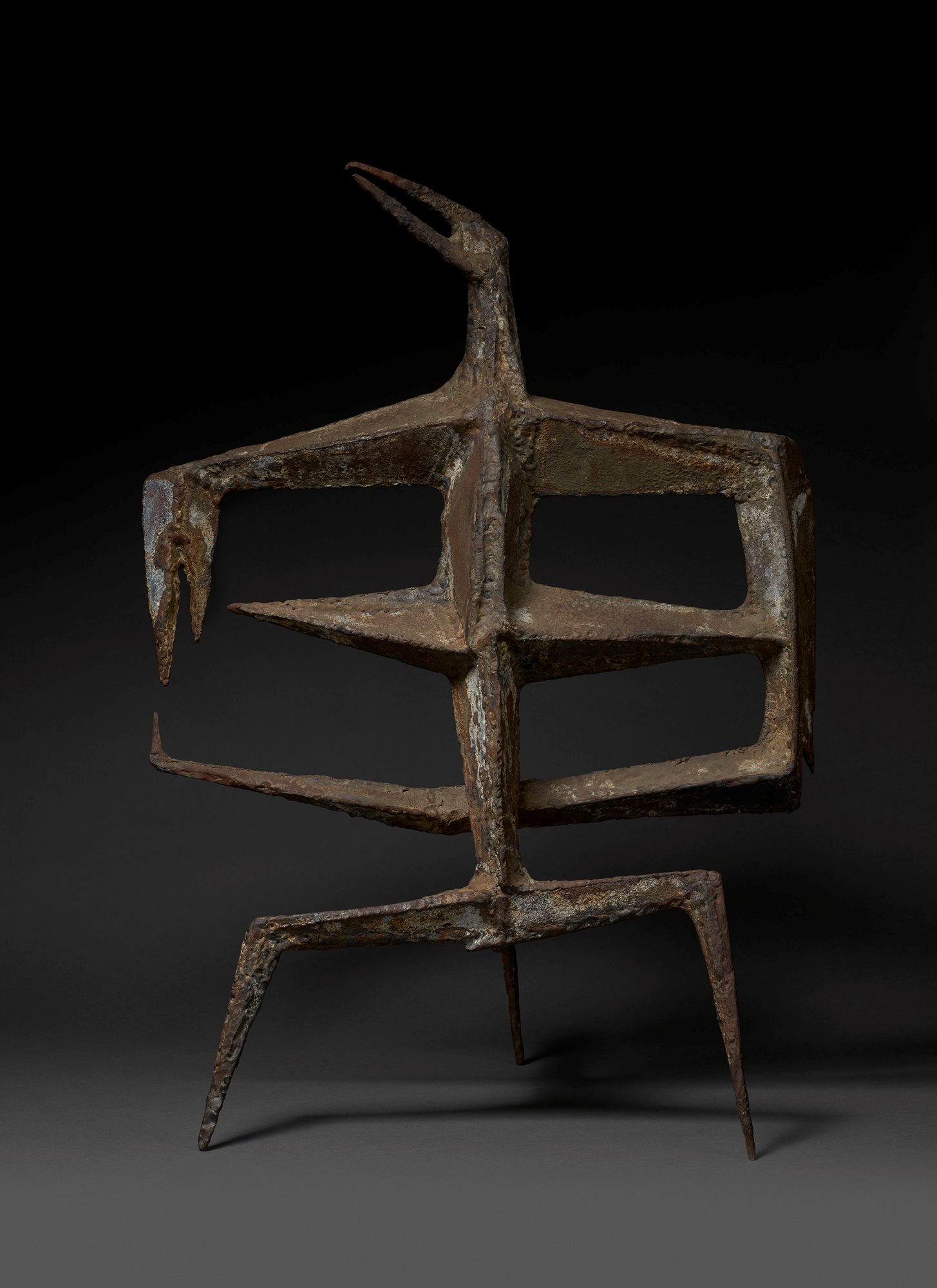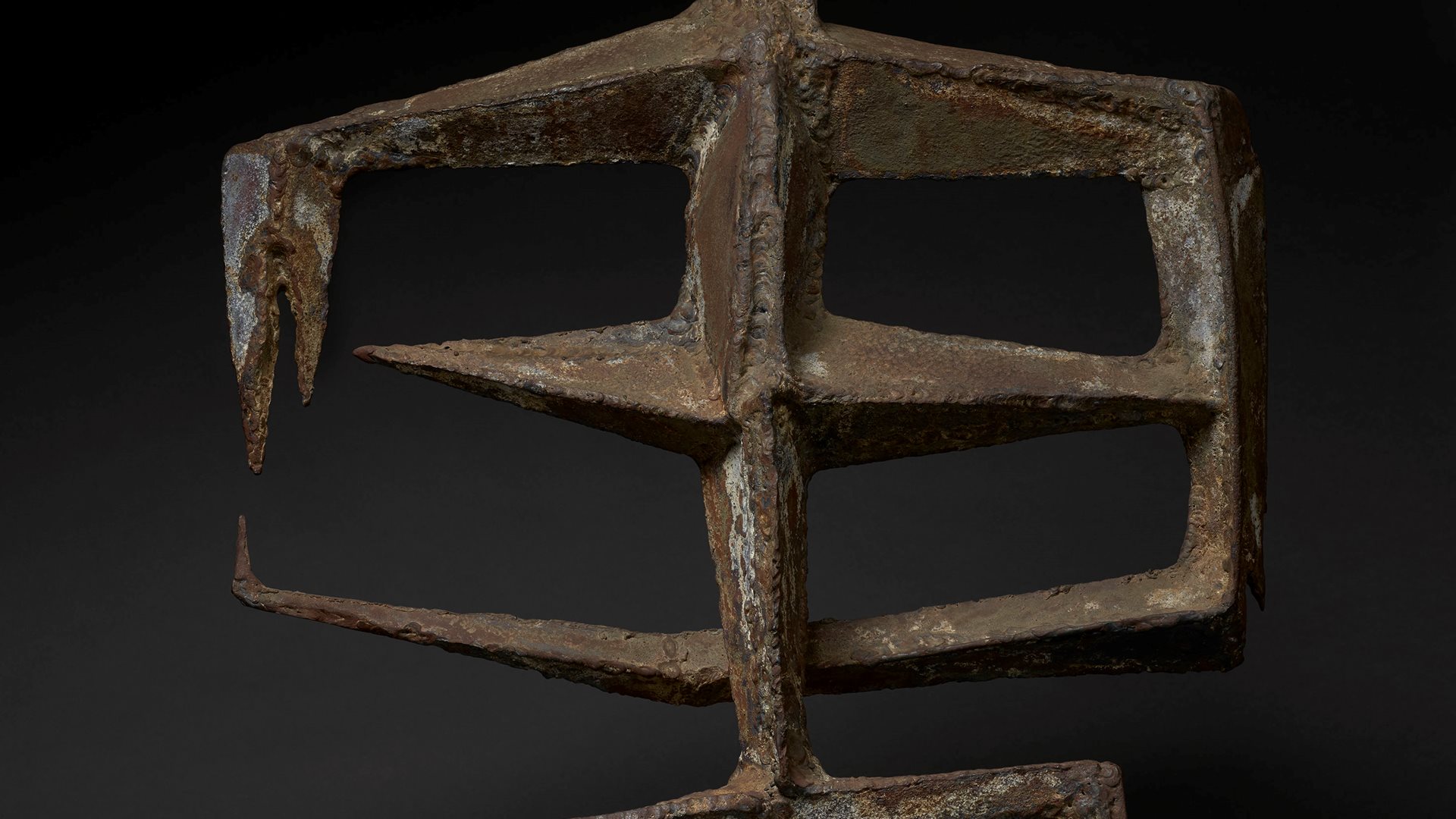

Provenance:
Gimpel Fils, London, where acquired in 1955 by;
Thomas C. Adler
and by descent to the previous owners, until 2022
Gimpel Fils, London, where acquired in 1955 by;
Thomas C. Adler
and by descent to the previous owners, until 2022
Literature:
D. Farr and E. Chadwick, Lynn Chadwick, sculptor: With a complete illustrated catalogue, 1947-2003, Lund Humphries, Farnham, 2014, no. 148, p. 147
D. Farr and E. Chadwick, Lynn Chadwick, sculptor: With a complete illustrated catalogue, 1947-2003, Lund Humphries, Farnham, 2014, no. 148, p. 147
‘I would call it attitude, you know, the way that you can make something almost talk by the way the neck is bent, or the attitude of the head’ Lynn Chadwick
Second Version of Snapping Turtle has previously only been known by a design illustrated in Denise Farr and Eva Chadwick, Lynn Chadwick, Sculptor: With a Complete Illustrated Catalogue, 1947 – 2003 (fig.1). The work was acquired directly from Gimpel Fils the year after its creation by Thomas C. Adler, a lifelong resident of Cincinnati and a patron and supporter of the arts, notably as a founder of the Contemporary Arts Center and a board member of the Cincinnati Art Museum.
In 1952, Chadwick was one of eight young sculptors chosen to represent Britain at the Venice Biennale. Although each artist showed very few pieces (Chadwick showed four sculptures and four drawings), this exhibition was important for it was in his catalogue introduction that Herbert Read coined the oft-quoted phrase, 'the geometry of fear'. Whilst Read's attempt to see a Jungian collective unconscious tendency within the work of the artists shown (Robert Adams, Kenneth Armitage, Reg Butler, Chadwick, Geoffrey Clarke, Bernard Meadows, Eduardo Paolozzi and William Turnbull) has been much questioned by art historians and critics, what is undeniable is that during the 1950s, a new generation had emerged onto the international sculpture stage.
Chadwick was central to this, and his position as a leading new artist was confirmed by his winning the International Sculpture Prize at the 1956 Venice Biennale, beating a host of international sculptors including Alberto Giacometti. Chadwick's fecundity of invention throughout the 1950s is clear when one considers that over three hundred pieces from that decade feature in the catalogue raisonné of his work. Within that extensive body of work, a number of themes emerge, one of the most prevalent being those derived from animal sources.
Chadwick's animals seem to be the almost primeval antecedents, in both character and appearance, of those we know. These beasts are strong, determined and aggressive, and regardless of their size the sense of challenge to the viewer is palpable. The method of making which Chadwick had refined in the early years of the decade enhanced this, the framework of welded iron rods giving the linear tension of the sculptures. Very rarely do these beasts have any identifiers beyond shape to give us a clue to their type or nature, these we learn from their attitude.
Second Version of Snapping Turtle has previously only been known by a design illustrated in Denise Farr and Eva Chadwick, Lynn Chadwick, Sculptor: With a Complete Illustrated Catalogue, 1947 – 2003 (fig.1). The work was acquired directly from Gimpel Fils the year after its creation by Thomas C. Adler, a lifelong resident of Cincinnati and a patron and supporter of the arts, notably as a founder of the Contemporary Arts Center and a board member of the Cincinnati Art Museum.
In 1952, Chadwick was one of eight young sculptors chosen to represent Britain at the Venice Biennale. Although each artist showed very few pieces (Chadwick showed four sculptures and four drawings), this exhibition was important for it was in his catalogue introduction that Herbert Read coined the oft-quoted phrase, 'the geometry of fear'. Whilst Read's attempt to see a Jungian collective unconscious tendency within the work of the artists shown (Robert Adams, Kenneth Armitage, Reg Butler, Chadwick, Geoffrey Clarke, Bernard Meadows, Eduardo Paolozzi and William Turnbull) has been much questioned by art historians and critics, what is undeniable is that during the 1950s, a new generation had emerged onto the international sculpture stage.
Chadwick was central to this, and his position as a leading new artist was confirmed by his winning the International Sculpture Prize at the 1956 Venice Biennale, beating a host of international sculptors including Alberto Giacometti. Chadwick's fecundity of invention throughout the 1950s is clear when one considers that over three hundred pieces from that decade feature in the catalogue raisonné of his work. Within that extensive body of work, a number of themes emerge, one of the most prevalent being those derived from animal sources.
Chadwick's animals seem to be the almost primeval antecedents, in both character and appearance, of those we know. These beasts are strong, determined and aggressive, and regardless of their size the sense of challenge to the viewer is palpable. The method of making which Chadwick had refined in the early years of the decade enhanced this, the framework of welded iron rods giving the linear tension of the sculptures. Very rarely do these beasts have any identifiers beyond shape to give us a clue to their type or nature, these we learn from their attitude.